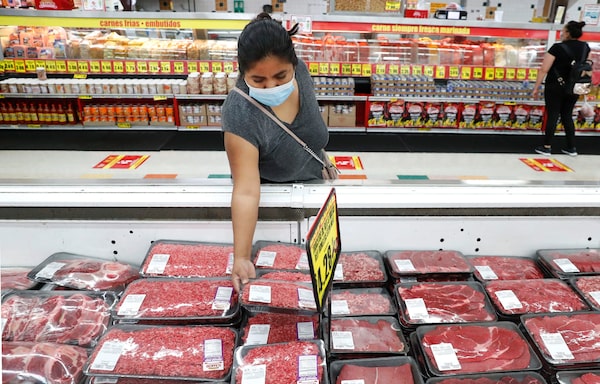
A shopper she looks over meat products at a grocery store in Dallas on April 29, 2020.LM Otero/The Associated Press
U.S. consumer prices rose moderately in January as an increase in the cost of gasoline was blunted by a slump in airline fares, suggesting inflation could remain benign for a while amid a pandemic that has fractured the labor market and services industry.
The Labor Department said on Wednesday its consumer price index increased 0.3 per cent last month after a downwardly revised 0.2 per cent gain in December. In the 12 months through January the CPI rose 1.4 per cent after advancing by a revised 1.3 per cent in December.
The CPI was previously reported to have increased 0.4 per cent in December and 1.4 per cent on a year-on-year basis. Last month’s rise in the CPI was in line with economists’ expectations.
Inflation is being closely watched this year, with economic growth expected to be juiced by fiscal stimulus and coronavirus vaccines becoming accessible to large swaths of the population, unleashing pent-up demand for services. Higher inflation is anticipated by the spring as price declines early in the coronavirus crisis wash out of the calculations.
Economists are, however, divided on whether faster inflation would stick beyond the so-called base effects. Some believe trillions in pandemic relief provided by the government will stoke price pressures. Others argue that labor market slack, characterized by at least 17.8 million on unemployment benefits, would make it harder for inflation to become entrenched.
The Federal Reserve has signaled it would tolerate higher prices after inflation persistently undershot the U.S. central bank’s 2 per cent target, a flexible average. The Fed has slashed interest rates to near zero and is pumping money into the economy through asset purchases. It is expected to maintain its ultra-easy monetary policy stance until mid-2023.
“Inflation is poised to rise above 2 per cent in the spring, but this will be driven largely by easy base effects and should be transitory,” said Kathy Bostjancic, chief U.S. financial economist at Oxford Economics in New York.
“Thus, the Federal Reserve should patiently look past this increase and delay rate liftoff until mid-2023.”
Wall Street’s main indexes opened at record highs. The dollar slipped against a basket of currencies. U.S. Treasury prices rose.
MUTED UNDERLYING INFLATION
Gasoline prices jumped 7.4 per cent in January, accounting for most of the increase in the CPI. That followed a 5.2 per cent rise in December. Food prices gained 0.1 per cent, but the cost of food consumed at home fell 0.1 per cent. Prices for food consumed away from home climbed 0.3 per cent.
Excluding the volatile food and energy components, the CPI was unchanged for a second straight month. The so-called core CPI was restrained by a 3.2 per cent plunge in the cost of airline tickets. That offset increases in the prices of health care, motor vehicle insurance and tobacco.
The core CPI rose 1.4 per cent on a year-on-year basis after gaining 1.6 per cent in December. The Fed tracks the core personal consumption expenditures (PCE) price index for its inflation target. The core PCE price index is at 1.5 per cent.
Spending on services, which accounts for more than two-thirds of the U.S. economy, remains 7.5 per cent below pre-pandemic level. Owners’ equivalent rent of primary residence, which is what a homeowner would pay to rent or receive from renting a home, nudged up 0.1 per cent, matching the rise in December. Many tenants have entered into forbearance agreements with landlords. Healthcare prices declined for a third straight month.
Be smart with your money. Get the latest investing insights delivered right to your inbox three times a week, with the Globe Investor newsletter. Sign up today.